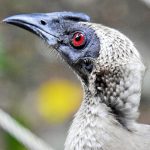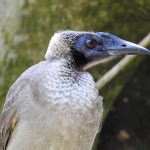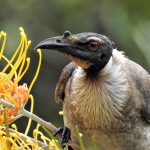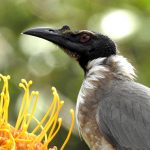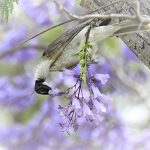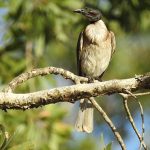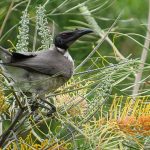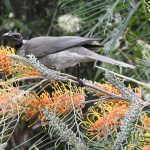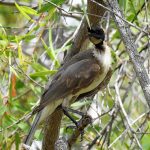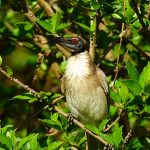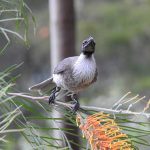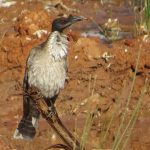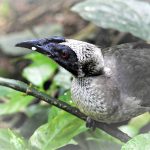NOISY FRIARBIRD
Philemon corniculatus
The tonsured head of this big honeyeater gives the friarbirds their name, with the Noisy Friarbird having the baldest head of all, which includes their upper neck as well. They also possess a strong curved beak with a prominent bump at the base, and they are known for their noisy nature!https:
The Noisy Friarbird is found in coastal regions from Cape York all the way down to south-eastern Victoria. They prefer open dry forests and eucalypt woodlands, as well as coastal scrub, heathlands, areas around wetlands and wet forests. They are found in most climate zones, even extending into arid areas along rivers. They thrive in planted native flowering urban environments. During spring and summer, the forests, woodlands, and urban areas resonate with the sound of this large arboreal honeyeater, chuckling, cackling, and bubbling as it calls and sings from the branches of flowering trees.
Both sexes look similar, with males slightly larger. They have distinct bare black-skinned, featherless heads and upper necks, resembling a mask. They also have a small black triangular knob at the base of the upper mandible, a narrow line of grey-brown feathering over the eye (eyebrow), and a triangle of silver-grey feathering on the chin. Their back, rump, shoulders, backs of wings, and tail are all fawn-brown to mid-grey, with a square-ended tail. Their lower throat and upper breast feature a ruff of lanceolate silvery-white feathers with dark shafts, while the lower breast to under the tail is pale fawn. Their eyes are a strong red, and their feet are dusky grey, with three toes facing forward and one backward.
To locate and establish their position, they emit a rolling, double-note chant, which becomes more harsh and crackling during feeding times and loud and brassy during pursuits. Their song consists of rippling, chuckling cackles, often in duet between sexes at specific perches, with the female’s voice being higher pitched.
Noisy Friarbirds are versatile feeders, consuming nectar, insects, and fruit, including grapes, blackberries, and even syrup that oozes from sugar cane after it has been burnt.
They are noisy, boisterous, and aggressive at feeding sites, with each bird defending its own branches, chasing off competitors, and calling out loudly in a cacophony of sound. All their feeding is done in trees, and their dexterous feet and claws allow them to hang upside down as they probe their long hooked beaks into flowers for nectar. They especially love Callistemon, Grevillea, and Eucalypt flowers and will also catch insects on the wing, only occasionally coming to the ground. They have been known to take small invertebrates and very small eggs. They will feed side by side with other honeyeaters, such as Red Wattlebirds, if there is plenty of food to go around.
Groups spread out to roost at night, with individuals not forming pairs but sleeping alone in tree crowns. They signal their position to one another, during twilight at dusk and dawn, with a repeated rolling “ya-kob” call.
Noisy Friarbirds form long-term pairs, with both parents defending the nest and its surroundings. Breeding occurs from July to February when they build a large, deep, open cup nest made of narrow strips of stringy bark interwoven with dry grasses, cobwebs, and stems. The nest is lined with even finer, softer grasses and is built in outer branches, often camouflaged in thick foliage up to 20m above the ground, occasionally in lower saplings. The female alone incubates usually 2-3 small light-dark pink, marble-spotted oval eggs. Both parents raise the chicks until they fledge and are ready to leave the nest, but the young birds often stay with the parents or within their group.
Although these unique-looking birds are not threatened, planting flowering Australian native trees, bushes, and shrubs in your garden can help them thrive.

